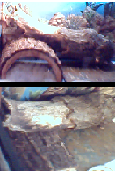Housing
Enclosures
Materials for Enclosures
Glass aquariums and glass terrariums work well as enclosures. However, some Bearded Dragons get upset if they see their reflections. In such cases, a background can do the trick. You can also use enclosures made out of plexiglass, wood, and/or melamine.
Wire and mesh are not generally good ideas. They don't hold in heat well enough.
As for the top, I personally love screen lids, they're great for ventilation while still keeping most of the heat in.
You can get cages at pet stores, garage sales, and classifieds both online and in newspapers. Or you can build your own cage. Directions to build your own cage can be found at Timeless Spirit Enclosure and Crossfire Enclosure.
Size
The bare minimum is a 40 gallon breeder (36 by 18 by 18 inches) for one fully grown Bearded Dragon.
The ideal tank size is 4 feet by 2 feet by 2 feet.
When choosing an enclosure size, it's important to keep in mind that some higher gallon numbers aren't wide enough, such as a 55 gallon (aka a 55 gallon long) that is only 48 by 13 by 21 inches. Since most Bearded Dragons are a minimum of 18 inches fully grown, a 55 gallon long will not be wide enough for them to turn around comfortably.
Substrate
Substrate (tank bottom) choice is important. This is because Bearded Dragons have delicate digestive systems prone to impaction (getting things stuck in their digestion system and not being able to pass it), which can be deadly.

There are some substrates that people will sell to you even though a huge number of Bearded Dragons die from them annually. These include calci-sand, repti-sand, walnut shell/desert blend, and gravels/pea rocks. If you use these, you are putting you're pet at a serious risk of being killed by it. Stay away from these.
There are also some other substrates that harbor so much bacteria and such that they are not good ones either. These include soils, mulches, corn cob, millet, and rabbit pellets.
There are, however, safe substrate choices. These include:

My personal favorite. This comes in a huge variety of colors. Just make sure that the surface of the tile is rough and textured for traction. Clean this thoroughly every month or so. You can clean it the same way you would clean the entire tank. Spot clean too of course. I recommend just placing them inside the tank without trying to seal them together, so that every tile can be removed if needed. Textured tiles have the added benefit of filing down claws. These can be found at Lowes and other home improvement stores.
|
Nonadhesive and Textured Shelf Liner |
|
Reptile Carpet Paper Towels |
|
Sand |
Enclosure Furniture
|
The Basking Site |
|
Climbing Furniture |
|
Rock Wall |
Digging
Many Bearded Dragons like to dig. If this is the case with yours, you may want to put a suitable area for digging in their terrariums. If you want to lower the risk of impaction, you can put in a box full of children's play sand in a certain part of their tank, rather than having play sand all over. Some will also dig into towels and be just as happy. Others don't care for digging at all.
Hides
Hides (little huts or some such they can go under) are good for older Bearded Dragons to give them a place to retreat to for privacy or shadow, but young ones may hide under them all the time at the price of reduced basking and reduced friendliness towards people. So it's best not to keep hides in their tanks until they are juveniles.
Rock
Rock of some sort is a good addition, because it files down the claws somewhat.
Claws can get very sharp so that they can break a keeper’s skin without any effort if such things are not included.
Humidity and Water Bowls
Humidity should be roughly 30-60%. Consider humidity when you decide whether or not to include a water bowl. If you do use a water bowl, clean it daily and choose one large enough for the Bearded Dragon to lay in, but still extremely shallow. Thoroughly cleaned containers from frozen dinners work well for water bowls. Not all Dragons drink from water bowls, but some will go to them to soak if they are having any digestive issues.
Cleaning the Enclosure
The enclosure should be spot-cleaned daily, wiped down once a week, and deep-cleaned at least once a month. A good cleaner is Nolvasan, which does not have harmful odors. Another is a diluted vinegar-water mix. Dilute it quite a bit, more than 10 parts water to 1 part vinegar. There are also commercial products on the market meant specifically for cleaning reptile enclosures that you can find at some pet stores.













